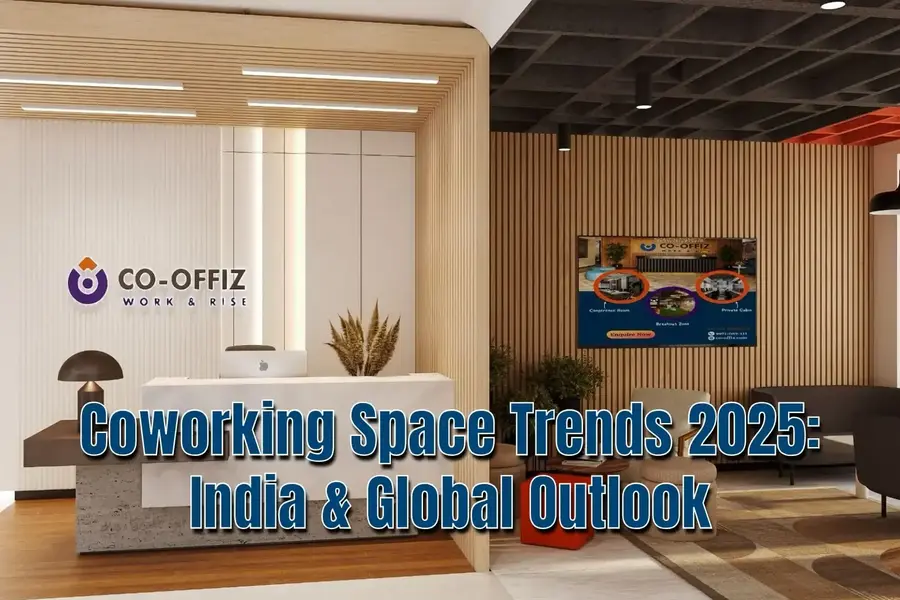Coworking Space Trends 2025: India & Global Outlook
The way we work is changing faster than ever. Coworking Space Trends 2025 show that professionals and businesses are moving away from rigid office setups and embracing flexible, collaborative work environments. Globally, the coworking industry is expected to hit $25.11 billion this year, while India has emerged as the world’s second-largest coworking hub—proving its role as a key player in the future of work.
But what’s driving this massive shift? It’s not just startups anymore—large corporations, SMEs, freelancers, and even hybrid employees are finding coworking spaces to be the smarter, more cost-effective solution.
Let’s explore how the coworking industry is growing worldwide, why India stands out, and what the future of work will look like by 2025 and beyond.
1. Industry Growth & Market Value
The global coworking industry has evolved from being a niche trend for freelancers into a mainstream model for businesses of all sizes.
🌍 Global Market Overview
- 2024: $22.01 billion
- 2025 (projected): $25.11 billion
- 2034 (projected): $82.12 billion (14.1% CAGR)
👉 This shows that coworking is no longer just a short-term office alternative—it’s becoming a long-term solution that supports business growth, scalability, and workforce flexibility.
🏢 Number of Spaces
- Worldwide: ~18,700 spaces in 2023 → projected to reach ~41,975 by 2024
- U.S.: 7,840 spaces (Q1 2025)
- UK & Ireland: 3,326 spaces by end of 2024
💡 With nearly 42,000 coworking spaces worldwide, professionals in almost every major city can now find flexible workspace solutions within minutes.
2. Key Benefits of Coworking Spaces
Why are companies and individuals shifting to coworking?
- Productivity: A professional environment with fewer distractions compared to home offices.
- Flexibility: Choose hot desks, dedicated desks, or private cabins depending on business needs.
- Networking: Coworking brings together entrepreneurs, freelancers, and corporates under one roof, opening doors to partnerships.
- Cost Efficiency: No heavy upfront investments—just pay for what you use.
- Work-Life Balance: Having a defined office helps professionals separate personal and work life.
💡 For startups, coworking spaces cut down setup costs by up to 40%. For corporates, they serve as plug-and-play satellite offices in new markets.
3. Essential Features
Today’s coworking spaces are designed to be more than just desks and Wi-Fi.
- Flexible areas: Hot desks, private cabins, meeting rooms
- Comfortable interiors: Ergonomic chairs, lounges, breakout zones
- Tech-ready infrastructure: High-speed internet, smart access, IoT tools
- Lifestyle amenities: Cafeterias, wellness areas, recreational lounges
- Community-driven culture: Networking events, workshops, and collaboration opportunities
👉 These features create a balance of professionalism and comfort, making coworking an attractive choice for modern professionals.
4. Coworking V/S Traditional Office
| Feature | Coworking Space | Traditional Office |
| Flexibility | High (short-term, scalable) | Low (long leases) |
| Networking | Cross-industry opportunities | Limited to internal team |
| Cost | Affordable, pay-as-you-go | High setup + maintenance |
| Amenities | Included in package | Often additional cost |
| Culture | Collaborative & vibrant | Fixed & formal |
💡 This comparison makes it clear—coworking offers far more agility, especially in uncertain market conditions.
5. Who Uses Coworking Spaces?
Coworking is not just for freelancers anymore.
- Freelancers & Startups: Flexible, low-cost setups without long commitments.
- Remote & Hybrid Workers: Balance between home comfort and office structure.
- Corporates & MNCs: Expansion offices, temporary project hubs, or client-facing locations.
👉 In fact, 40% of Fortune 500 companies already use coworking spaces for at least one function.
6. India’s Coworking Market Highlights
India has become one of the fastest-growing coworking markets in the world, thanks to its startup culture and affordable real estate compared to the West.
📊 Market Size & Growth
- 2024: $1.94 billion
- 2025: $2.08 billion (projected)
- 2030: $2.91 billion (7% CAGR)
👉 India now accounts for nearly 10% of the world’s coworking spaces.
🚀 Key Growth Drivers
- Startups & SMEs: Cost-efficient growth.
- Remote work adoption: Especially after the pandemic.
- Government support: Startup India & tax incentives for businesses.
🌍 Geographical Spread
- Metros: Bengaluru (25%), Mumbai (13%), Delhi NCR, Hyderabad, Pune.
- Tier-2/3 cities: Jaipur, Coimbatore, Tirunelveli → rapid adoption.
💡 The rise of Tier-2 and Tier-3 cities shows coworking is no longer just a metro phenomenon—it’s becoming a national movement.
🏢 Record Leasing & Absorption
- 2024: Coworking = 20% of India’s total office leasing (~15.3M m²).
- Q1 2023: 27% of new office absorption in top 7 cities came from coworking.
🧘 Tech & Wellness Integration
- Smart spaces: AI, IoT, visitor tracking.
- Well-being: Yoga zones, ergonomic furniture, air quality sensors.
7. Future Trends
- Hybrid Work Models – The biggest driver of coworking demand.
- Smart Technology – Automation, biometric access, IoT integration.
- Tier-2/3 Expansion – Affordable spaces in smaller cities.
- Sustainability & Green Workspaces – Eco-friendly offices with wellness zones.
👉 The future of coworking is not just about work—it’s about creating healthy, sustainable, and tech-driven ecosystems.
8. Why India’s Coworking Market Stands Out
India is unique because:
- It has 112,000+ startups and 111 unicorns (3rd largest in the world).
- The government actively supports entrepreneurs with policies & incentives.
- Affordable infrastructure + young workforce makes it ideal for coworking growth.
💡 India’s coworking story is about innovation and inclusivity—spaces here are not just workstations but communities where businesses thrive.
9. FAQs
Question 1: What is the coworking market size in India in 2025?
India’s coworking industry is projected at $2.08 billion in 2025, growing steadily at 7% CAGR.
Question 2: How big is the global coworking market in 2025?
The worldwide coworking market is expected to reach $25.11 billion in 2025.
Question 3: Why are companies moving to coworking spaces?
Because coworking offers flexibility, affordability, modern amenities, and networking opportunities that traditional offices lack.
Question 4: Which Indian cities are leading in coworking adoption?
Top cities: Bengaluru, Mumbai, Delhi NCR, Hyderabad, Pune, with Jaipur & Coimbatore emerging.
Conclusion: Coworking Space Trends 2025
Coworking is no longer an option—it’s the backbone of the future workplace. Globally, it’s set to become a $25 billion industry this year, and in India, it’s transforming how startups, corporates, and freelancers work.
With hybrid models, smart technology, and sustainable design leading the way, 2025 will redefine workspaces into thriving communities of innovation and growth.
Co-Offiz provides premium coworking offices for startups, professionals, and corporates.
📍 Locations:
-
Janakpuri (West Delhi)
-
Preet Vihar (East Delhi)
-
Netaji Subhash Place (North Delhi)
-
Noida Sec-63
-
Gurugram Sec-58
✨ Features: Flexible seating, private cabins, meeting rooms, high-speed internet, cafeteria, community events & 24/7 support.
📞 Call us: 9971089111
🌐 Visit: www.co-offiz.com
👉 Join Co-Offiz today and experience the smarter way of working in Delhi NCR.


